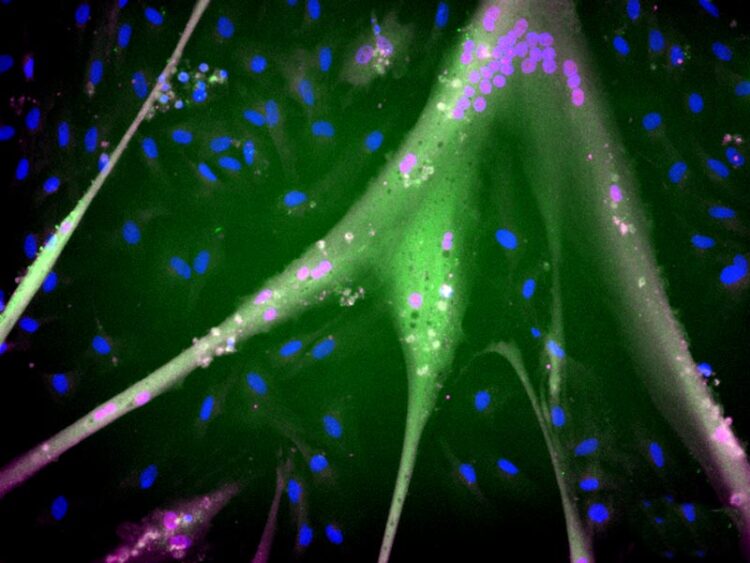Meat grown from immortal stem cells

Differentiated immortalized bovine stem cells with fully expressed muscle proteins (blue = nuclei; magenta = myogenin; green = myosin). Scale approx 1 mm.
Credit: Andrew Stout, Tufts University
Another step away from the farm:
Reducing the need to biopsy animals, the stem cells provide a potentially endless source for cultured meat.
To make it possible for cellular agriculture—the process of growing meat in bioreactors—to feed millions of people, several technical challenges will have to be overcome. Muscle cells from chicken, fish, cows, and other food sources will have to be grown to produce millions of metric tons per year.
Toward this goal, researchers at Tufts University Center for Cellular Agriculture (TUCCA) developed immortalized bovine muscle stem cells (iBSCs) that can grow rapidly and divide hundreds of times, and possibly indefinitely. This advance, described in the journal ACS Synthetic Biology, means that researchers and companies around the globe can have access to and develop new products without having to source cells repeatedly from farm animal biopsies.
The production of cell-cultured meat will require muscle and fat cells with a very high capacity to grow and divide. While cell-grown meat has garnered media attention with examples such as the FDA preliminary approval of cultured chicken, and even a hamburger grown with mastodon DNA, the products are still expensive and difficult to scale up.
Normal muscle stem cells drawn from live animals to start a culture typically divide only about 50 times before they start to get “old” and are no longer viable. While it is theoretically possible for these stem cells to produce a substantial amount of meat, the immortalized cells developed by the TUCCA team offer several advantages. One is the possibility of producing significantly more mass for meat production.
Another advantage is that by making the immortalized cells widely available, they will lower the barrier of entry for other researchers to explore cellular agriculture — finding ways to reduce costs and overcome challenges to scaled-up production.
“Typically, researchers have had to do their own isolations of stem cells from animals, which is expensive and laborious, or use model cell lines from less relevant species, like mouse muscle cells,” said Andrew Stout, a graduate student at TUCCA and lead researcher on the project, “Using these new persistent bovine cell lines, their studies can be more relevant, literally getting right to the meat of the matter.”
Two steps were key to transforming regular bovine muscle stem cells into the immortalized bovine muscle stem cells. Most cells, as they divide and age, begin to lose DNA at the ends of their chromosomes, which are called telomeres, like worn ropes that get frayed with use. This can lead to errors when the DNA is being copied or repaired. It can also cause genes to be lost and, eventually, cells to die.
The researchers engineered the bovine stem cells to constantly rebuild their telomeres, effectively keeping their chromosomes “youthful” and ready for another round of replication and cell division.
The second step to immortalizing the cells was to make them continuously produce a protein that stimulates a critical stage of cell division. This effectively turbocharges the process and helps the cells to grow faster.
Muscle stem cells are not the final product that one wants to eat. They must not only divide and grow, but also differentiate into mature muscle cells just like, or at least very similar to, the muscle cells that we eat in a steak or fillet. Stout and his research team found that the new stem cells did indeed differentiate into mature muscle cells, although not entirely identical to animal muscle cells or muscle cells from conventional bovine stem cells.
“It’s possible that they are matured enough to replicate the flavor and texture of natural meat,” said Stout, “That’s something we will have to explore further. They are doubling at a very rapid rate, so they might just need a little more time to reach full maturity.”
“While some may question whether it is safe to ingest immortalized cells, in fact, by the time the cells have been harvested, stored, cooked, and digested, there is no viable path to continued growth,” said David Kaplan, Stern Family professor of biomedical engineering at Tufts and director of TUCCA. “Like natural meat we eat today, the cells simply become inert material that we hope will taste delicious and provide a wide range of nutritious benefits.”
New Cellular Agriculture Consortium Will Help Develop the Foods of the Future
Lab-Grown Fat Could Give Cultured Meat Real Flavor and Texture
Journal: ACS Synthetic Biology
DOI: 10.1021/acssynbio.3c00216
Method of Research: Experimental study
Subject of Research: Cells
Article Title: Immortalized Bovine Satellite Cells for Cultured Meat Applications
Article Publication Date: 5-May-2023
COI Statement: No conflicts of interest have been declared
Media Contact
Mike Silver
Tufts University
mike.silver@tufts.edu
Office: 6176270545
All latest news from the category: Life Sciences and Chemistry
Articles and reports from the Life Sciences and chemistry area deal with applied and basic research into modern biology, chemistry and human medicine.
Valuable information can be found on a range of life sciences fields including bacteriology, biochemistry, bionics, bioinformatics, biophysics, biotechnology, genetics, geobotany, human biology, marine biology, microbiology, molecular biology, cellular biology, zoology, bioinorganic chemistry, microchemistry and environmental chemistry.
Newest articles

NASA: Mystery of life’s handedness deepens
The mystery of why life uses molecules with specific orientations has deepened with a NASA-funded discovery that RNA — a key molecule thought to have potentially held the instructions for…

What are the effects of historic lithium mining on water quality?
Study reveals low levels of common contaminants but high levels of other elements in waters associated with an abandoned lithium mine. Lithium ore and mining waste from a historic lithium…

Quantum-inspired design boosts efficiency of heat-to-electricity conversion
Rice engineers take unconventional route to improving thermophotovoltaic systems. Researchers at Rice University have found a new way to improve a key element of thermophotovoltaic (TPV) systems, which convert heat…



